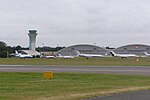Eelmoor Marsh

Eelmoor Marsh is a 66.3-hectare (164-acre) biological Site of Special Scientific Interest between Fleet and Farnborough in Hampshire. It is part of Thames Basin Heaths Special Protection Area for the conservation of wild birds.This site has a bog with deep peat, grass heath, woodland and a network of ditches. The bog has more than 250 species of flowering plants and grasses, including the insectivorous common butterwort, pale butterwort, small bladderwort and common sundew. There is also a diverse invertebrate fauna.Eelmoor Marsh has been managed by Marwell Wildlife since 1995, including conservation grazing using the endangered Przewalski's horse and as a site for the reintroduction of the sand lizard, one of the U.K.'s rarest reptiles
Excerpt from the Wikipedia article Eelmoor Marsh (License: CC BY-SA 3.0, Authors, Images).Eelmoor Marsh
Tyte Track, Rushmoor
Geographical coordinates (GPS) Address Nearby Places Show on map
Geographical coordinates (GPS)
| Latitude | Longitude |
|---|---|
| N 51.274 ° | E -0.797 ° |
Address
Tyte Track
Tyte Track
GU14 0LL Rushmoor
England, United Kingdom
Open on Google Maps




